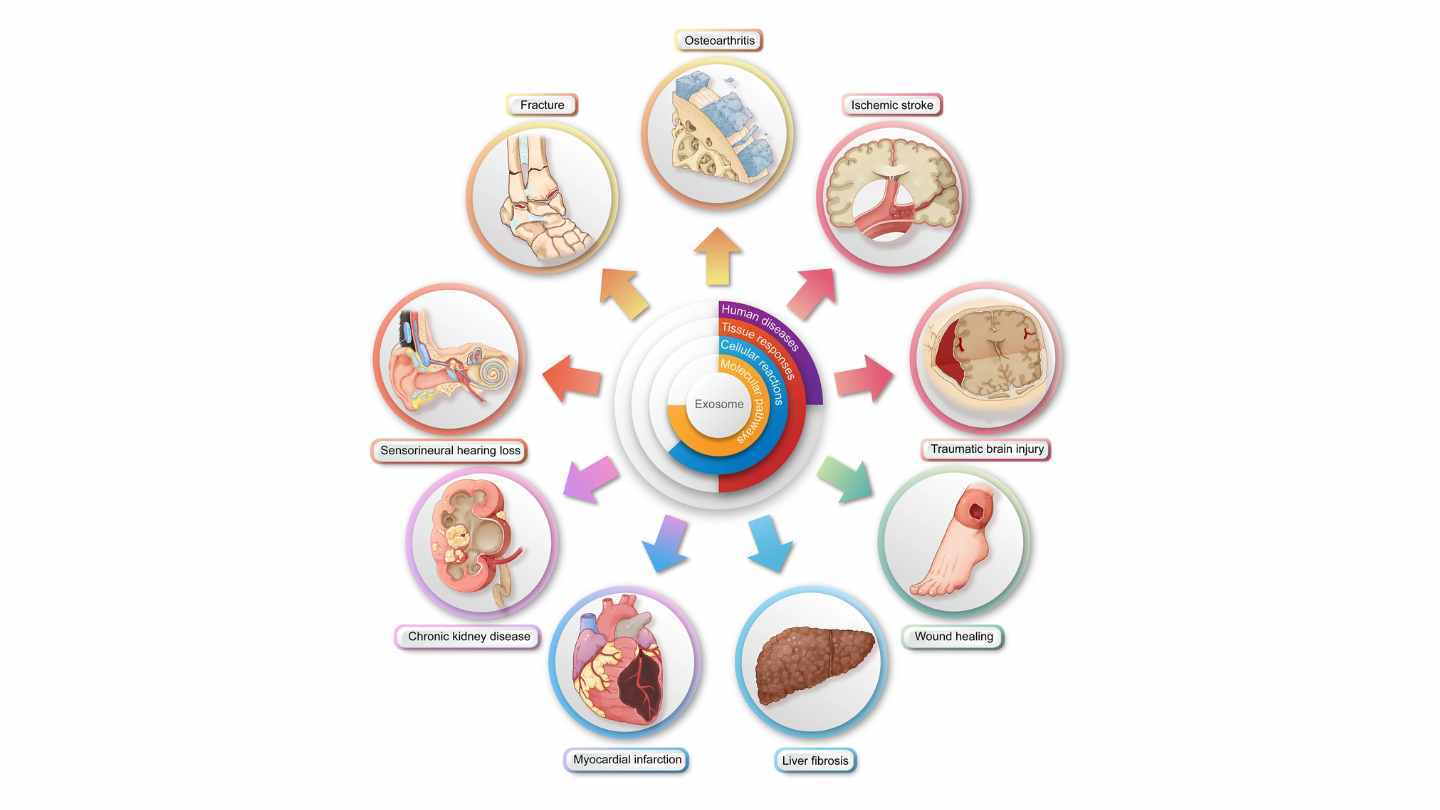Recent strides in translational medicine are revolutionising disease treatment, with exosomes leading the charge.
These tiny messengers, derived mainly from stem cells, are not just transforming drug delivery but also holding the key to longevity and healthy ageing.
Whilst politicians worldwide are stuck in old ways, scientists are moving fast, developing advanced systems that overcome traditional limitations.
Exosomes, with their natural ability to communicate between cells, offer precise and effective solutions for treating or potentially preventing diseases.
Discover how these incredible innovations can extend healthy lifespans and transform modern medicine in this Avea blog.

Highlight
- Exosomes, secreted by nearly all cells and body fluids, carry a rich cargo of proteins, lipids, RNA, and DNA, closely mimicking their cells of origin.
- Their unique properties make them powerful allies in combating neurodegenerative, infectious, musculoskeletal, and cardiovascular disorders.
- By targeting at the cellular level, exosomal therapy can be used to leverage our body’s own defence mechanisms, offering a promising future for personalised medicine.
In this article
FREE anti-ageing guide

- Master the science of rejuvenation.
- Apply proven tips to turn back the clock.
- Transform your health with top longevity specialists.
What are exosomes?
Exosomes are tiny particles that carry various substances like proteins, RNA, and DNA, acting as messengers between your cells. We’re talking – thousands of information that vary, based on the origin of the parent cells.
Exosomes contain a high concentration of key proteins that help in their identification. Some common ones include membrane transport proteins, chaperones, and adhesion molecules.
These vesicles are also rich in lipids, and contain important molecules involved in metabolism and signalling, making them vital for various functions in the body.
Where do exosomes come from?
Isolating and studying exosomes from body fluids, like blood and urine can be challenging, but essential for understanding their potential in medicine.
Researchers use several methods to separate and analyse exosomes, such as
- ultracentrifugation
- filtration
- chromatography
These techniques help identify exosomes based on their size and shape.
Advanced tools like electron microscopy and genetic sequencing provide detailed insights into the contents of exosomes.
Despite the complexity, understanding exosomes can lead to breakthroughs in treating diseases, as they offer a way to deliver targeted therapies directly to affected cells.
Standardising these methods is crucial to ensure consistent and accurate results in exosome research.
Can exosomes help in diagnosing diseases and conditions?
Exosomes can be used to diagnose diseases, due to their ability to facilitate intercellular communication. They can reveal the progression of diseases by carrying substances from both inside and outside cells.

They are particularly significant in diagnosing cerebrovascular diseases, central nervous system disorders, cancers, and diseases affecting the kidneys, liver, and lungs [1].
Likewise, exosomes help identify these conditions by detecting specific proteins and genetic materials on their surfaces, which are linked to pathological processes.
What is exosomal therapy?
Exosomes can be engineered to deliver specific cargoes to diseased tissues, through mechanisms such as endocytosis or membrane fusion.
They are a promising tool in regenerative medicine and targeted therapy, as these tiny carriers ensure a sustained release of therapeutic agents at the intended site, thereby enhancing their effectiveness.
With their low immunogenicity (the ability to provoke an immune response in the body) and ability to cross the blood-brain barrier, exosomes are also excellent vectors for delivering biological responses.
Their stable lipid bilayer protects the cargo within from immune cells and digestive enzymes, ensuring that therapeutic agents reach their target intact.
Let’s take Mesenchymal stromal cell-derived exosomes, as an example. These are multipotent stem cells found in various tissues, such as bone marrow, fat, and umbilical cord, that can differentiate into a variety of cell types, including bone, cartilage, and fat cells.
- They exhibit properties that support cell viability, reduce inflammation, and modulate the immune system.
- They promote the formation of new blood vessels and cell proliferation, demonstrating a homing effect that mimics the behaviour of their parent cells.
But if they’re similar to stem cells, why use exosomes instead in therapies?
Reverse your age by 6.5 years like Ibrahim

- Explore the secrets behind Ibrahim’s transformation.
- Discover simple, proven strategies to improve vitality.
- Understand the role of supplements in reversing biological age.
Benefits of exosomes over stem cells
Exosomal cargos have several advantages over stem cells, making them superior for clinical and therapeutic applications.
- They do not carry the inherent risks associated with cell-based therapies, such as stem cells, including the potential for replication and malignant transformation.
- Exosomes also do not provoke immunogenic responses towards infections and cancers, ensuring a safer profile.
- They offer targeted action at specific sites of interest, enhancing their effectiveness.
- The versatility of exosomal vesicles (EVs) boosts their intracellular signalling capabilities, and allows them to cross cellular membranes, restoring molecular balance within cells.
- They provide neuroprotection, and support neuroplasticity by crossing the blood-brain barrier, making them valuable in treating neurodegenerative diseases.
Globally, 77 clinical trials have been registered to explore the potential of exosome-based treatments across various pathologies.
Of these, 11 completed trials have demonstrated the positive diagnostic and therapeutic effects of exosomes in treating cancers, neurodegenerative, and haematological diseases, highlighting their promising role in future medical treatments.
Routes of delivery of exosomes
The delivery of exosomes to their site of action can be achieved through various methods, each with its own set of challenges.
- The most common route is intravenous (IV), despite the rapid clearance of exosomes by the liver and kidneys. This method is widely used for treating orthopaedic, neoplastic, and cardiovascular conditions.
- The intramuscular (IM) route is primarily used for neuromuscular and musculoskeletal conditions.
- The subcutaneous (SC) route is preferred for aesthetic and cosmetic purposes.
The intramuscular and subcutaneous routes are favoured for their ease of administration and appropriate dosing volumes.
- For neurodegenerative conditions such as Alzheimer’s, Parkinson’s, and Creutzfeldt-Jakob disease, the intrathecal route is preferred.
- Local aerosol sprays are employed in the management of wounds and ulcers, and, are also used for hair growth and rejuvenation in age-related therapies.
Sources of exosomes
Also known as intraluminal vesicles, exosomes are found in various tissues and fluids in your body.
Those derived from mesenchymal stem cells (MSCs) are particularly significant due to their high therapeutic and regenerative potential.
These exosomes exhibit intracellular signalling and communication with targeted tissues. Key sources of MSC-derived exosomes include bone marrow, adipose tissue, placental cells, umbilical cells, endometrial fluid, and amniotic fluid.
MSC-origin exosomes have hundreds of cell surface markers embedded in them. These markers play crucial roles in:
- repair and regeneration
- bioenergetics
- immunoregulation
- intracellular communication
- tissue metabolism
For instance, a proteomic analysis of bone marrow MSC-derived exosomes has identified 730 protein molecules, showing the complex and versatile nature of these exosomes.
Researchers have also discovered transcription signalling factors in exosomal cargoes.
Amongst those, amniotic fluid exosomes are preferred for clinical applications due to their superior properties compared to bone marrow-derived exosomes.
Science-backed longevity supplements

- Maximise your energy production.
- Improve your mental clarity and focus.
- Achieve smoother, more radiant skin within 30 days.
Is exosomal therapy legal?
With the growing use of exosomal therapy, international guidelines ensure their safe and effective clinical use.
The International Society for Extracellular Vesicles (ISEV) and the European Network on Microvesicles and Exosomes in Health and Disease (ME-HaD) have established standards for collecting, processing, testing, quality control, and manufacturing exosomes.
Currently, no exosome products are FDA-approved for human use in the USA.
The FDA classifies exosomes as a 351 product, requiring studies to prove their safety, efficacy, purity, and potency. Exosome therapies are in the Investigational New Drug (IND) phase and need regulatory approval before clinical trials can start.
The regulatory framework mandates rigorous safety standards for microbial and viral contamination and adherence to GxP standards (good manufacturing, laboratory, distribution, clinical, and scientific practices).
This ensures ethical and safe clinical trials, although categorising new therapeutic products for human use remains a challenge.
How safe are exosomes?
Identifying the “active substances” within exosomes, understanding their properties, and establishing essential quality controls are vital for manufacturing clinical-grade products.
Despite uncertainties about the mechanism of actions of extracellular vesicles-based therapeutics on target cells, animal models suggest that extracellular vesicles from human cells do not pose a high risk in Investigational New Drug (IND) applications.
Large-scale manufacturing of these therapeutics demands a robust quality management system, advanced facilities, and compliance with GxP standards to ensure safety for both donors and patients.
Establishing standardised protocols is essential to advance the clinical application and commercialisation of these promising therapies, ensuring their safety, efficacy, and reproducibility in clinical settings.
Direction for future research
The potential of exosomal therapy in various clinical fields has remained largely unexplored till now.
But as global interest in exosome-based therapeutics grows, making them a reality is becoming easier.
Current research focuses on developing diagnostic and therapeutic applications for patient care. By measuring circulating exosomes in blood, early diagnosis of complex diseases could be achieved using them as biomarkers [2].
Exosome-based therapies have already shown promise in
- treating orthopedic conditions
- neurodegenerative disorders
- autoimmune diseases
- cardiovascular diseases
- infectious diseases
- rare diseases, including cancers
Companies like Capricor Therapeutics are developing exosomal therapeutics, such as CAP-2003 from cardiosphere-derived cells (CDCs), which are in preclinical testing for their anti-inflammatory, pro-angiogenic, antiapoptotic, and antifibrotic effects.
Capricor is also exploring CDC-exosomes for treating trauma-related injuries and conditions, highlighting the commercial and therapeutic potential of exosome-based innovations.
What are the clinical applications of exosomes?
1. Cancer diagnosis and therapy
Exosomes are extensively studied for their potential in cancer diagnosis and therapy. They carry tumour-specific biomarkers that can be detected in body fluids, enabling non-invasive cancer diagnostics through liquid biopsies.
This approach can identify circulating tumour cells and genetic mutations associated with cancer, providing crucial information for early diagnosis and treatment monitoring.
Moreover, exosomes can be engineered to deliver anti-cancer drugs directly to tumour sites, enhancing the efficacy and reducing the side effects of chemotherapy.
2. Neurological disorders
Exosomes show great promise in treating neurological disorders. Their ability to cross the blood-brain barrier makes them ideal candidates for delivering therapeutic agents to the brain.
Research has demonstrated their potential in treating conditions like Alzheimer’s and Parkinson’s diseases by transporting neuroprotective molecules that promote neuronal survival and reduce neuroinflammation.
Mesenchymal stem cell-derived exosomes are particularly noted for their regenerative capabilities in neural tissues.
3. Cardiovascular diseases
In cardiovascular medicine, exosomes are being explored for their role in repairing damaged heart tissues. Mesenchymal stem cell-derived exosomes have been shown to promote angiogenesis, reduce inflammation, and prevent apoptosis in heart cells, which are critical for heart repair after events like myocardial infarction. Their regenerative properties and ability to modulate immune responses make them valuable in developing treatments for various heart conditions.
4. Inflammatory and autoimmune diseases
Exosomes also hold potential in managing inflammatory and autoimmune diseases. Their immunomodulatory properties allow them to either suppress or activate immune responses as needed. For instance, MSC-derived exosomes can reduce inflammation and promote tissue repair in conditions like rheumatoid arthritis and inflammatory bowel disease. This capability is attributed to the bioactive molecules they carry, which can modulate immune cell activity and cytokine production.
5. Wound healing and regeneration
In the realm of regenerative medicine, exosomes are used to enhance wound healing and tissue regeneration. They promote cell proliferation, migration, and angiogenesis, making them effective in treating chronic wounds and enhancing the healing process in skin injuries. The use of exosomes in sprays or topical formulations is being investigated for their ability to deliver therapeutic agents directly to the wound site, accelerating recovery.
References
















